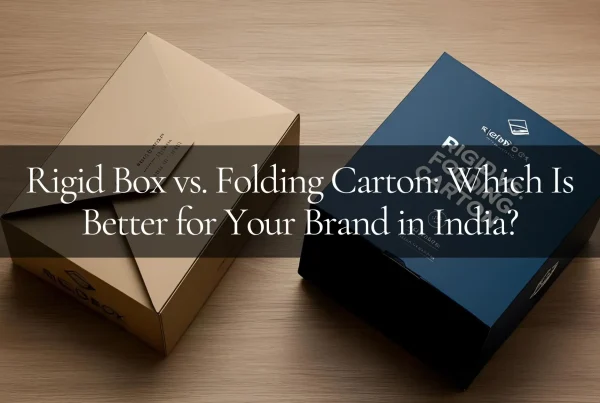In the competitive world of chocolate marketing, packaging plays a crucial role in catching the consumer’s attention and influencing their purchasing decisions. Beyond just protecting the delicious contents inside, chocolate package box aesthetics have become an important factor in standing out on store shelves and creating a memorable brand experience.
Understanding the Role of Packaging in Chocolate Marketing
The psychology behind packaging goes beyond mere functionality. It taps into the subconscious of consumers, triggering emotions, and shaping perceptions of the product. Visual appeal plays a significant role in capturing attention and creating an initial impression that can either attract or repel potential buyers.
From the color scheme to the font choice, every element of the packaging design contributes to the overall perception of the chocolate brand. Understanding these influences can help companies create packaging that effectively communicates their brand identity and connects with their target audience.
The Psychology Behind Packaging
Packaging design has the power to evoke specific emotions and associations in consumers’ minds. For example, bold and vibrant packaging colors can create a sense of excitement and indulgence, while soft pastel tones may convey a sense of delicacy or sophistication. Through careful design choices, companies can align their packaging with the desired emotions and traits they want their brand to be associated with.
Imagine walking down the chocolate aisle in a supermarket. Your eyes are immediately drawn to a package adorned with rich, deep hues of gold and burgundy. The intricate patterns on the wrapper evoke a sense of luxury and elegance. Without even tasting the chocolate, you can already imagine the smooth, velvety texture melting in your mouth. This is the power of packaging design – it sets the stage for the entire chocolate experience.
The Impact of Visual Appeal on Consumer Choices
When faced with a wide array of chocolate options, consumers often rely on visual cues to guide their decision-making process. Research has shown that consumers are more likely to choose products with attractive packaging. Eye-catching design elements, such as intricate patterns or unique shapes, can make a chocolate bar stand out from the competition and entice consumers to give it a try.
Picture a chocolate bar with a packaging design that breaks away from the traditional rectangular shape. Its edges are curved, mimicking the smoothness of the chocolate inside. The wrapper is adorned with a mesmerizing geometric pattern that seems to dance under the store’s bright lights. As you hold the bar in your hands, you can’t help but feel a sense of curiosity and anticipation. This unconventional packaging design has successfully captured your attention and sparked your interest.
Additionally, packaging can communicate important information about the product, such as its ingredients, flavor profile, or special qualities. Clear and visually appealing labels can make it easier for consumers to make informed choices and identify the chocolate that best suits their preferences.
Imagine picking up a chocolate bar and immediately noticing a label that proudly proclaims “Made with organic, ethically sourced cocoa beans.” The packaging also features a mouthwatering image of the chocolate, showcasing its smooth, glossy appearance. This combination of transparency and visual appeal reassures you that you are making a conscious and delicious choice.
The Art of Chocolate Packaging Design
Creating effective chocolate packaging requires a combination of elements that capture attention, communicate brand values, and enhance the overall consumer experience.
When it comes to designing chocolate packaging, every detail matters. From the choice of materials to the finishing touches, each element contributes to the overall appeal of the product. Packaging designers often take inspiration from various sources, such as art, nature, and cultural trends, to create packaging that stands out on the shelves and resonates with the target audience.
Elements of Effective Chocolate Packaging
Effective chocolate packaging designs often incorporate a careful balance of simplicity and creativity. Clean and minimalist designs can convey a sense of elegance and sophistication, while creative and unique designs can capture the viewer’s curiosity and make the product unforgettable. Texture, embossing, and foiling techniques can also add a luxurious feel to the packaging, elevating the overall brand experience.
Furthermore, the structural design of chocolate packaging is crucial in not only protecting the product but also in creating a memorable unboxing experience for the consumer. Innovative structural elements, such as unique opening mechanisms or interactive features, can add an element of surprise and delight, making the act of unwrapping a chocolate bar even more enjoyable.
The Role of Color and Typography in Packaging
Color and typography are powerful tools in packaging design that can evoke specific emotions and convey brand personality. For example, warm hues like rich browns and golds can evoke a sense of indulgence and luxury, while vibrant and playful colors can create a youthful and energetic brand image.
The choice of typography also plays a crucial role in packaging design. Fonts convey personality and can suggest traditional, modern, or sophisticated qualities, depending on the brand’s positioning. Clear and legible typography ensures that the packaging effectively communicates important information to the consumer.
Overall, the art of chocolate packaging design is a delicate balance of creativity, functionality, and brand storytelling. Each element, from the color palette to the typography choices, contributes to the consumer’s perception of the product and the brand behind it.
The Relationship Between Packaging and Brand Identity
Chocolate packaging is not just a means to attract attention; it is a vehicle to communicate the brand’s values, differentiate itself from competitors, and create a lasting impression in the consumer’s mind.
When it comes to packaging design, every element plays a crucial role in shaping the brand identity. From the choice of colors and fonts to the imagery and messaging, each component contributes to conveying the brand’s story and connecting with the target audience on a deeper level.
How Packaging Reflects Brand Values
The design choices made in chocolate packaging should align closely with the brand’s values and mission. For example, companies that prioritize sustainability may opt for eco-friendly materials and minimalistic packaging designs to showcase their commitment to the environment. On the other hand, brands focusing on indulgence and luxury may choose elaborate and ornate packaging to create a sense of opulence and exclusivity.
Moreover, the tactile experience of the packaging, such as the texture of the materials used or the opening mechanism, can also reflect the brand’s values. A brand that emphasizes simplicity and transparency may choose straightforward, easy-to-open packaging, while a brand that values innovation and creativity may opt for unconventional packaging designs that surprise and delight consumers.
The Influence of Packaging on Brand Perception
Package aesthetics greatly impact how consumers perceive the brand and its products. A high-quality and visually appealing packaging can enhance the perception of the chocolate’s taste and overall quality, leading to positive brand associations in the consumer’s mind. On the contrary, poorly designed or unappealing packaging can create doubts about the product’s quality, even if it is delicious.
In addition to visual appeal, the functionality of the packaging also plays a significant role in shaping brand perception. Packaging that is convenient, practical, and protects the product effectively can enhance the overall customer experience and reinforce positive associations with the brand.
Sustainable Practices in Chocolate Packaging
In an era where sustainability and environmental consciousness are becoming increasingly important, chocolate brands are embracing eco-friendly packaging solutions.
One innovative approach that chocolate companies are taking to reduce their environmental impact is incorporating plant-based materials into their packaging. By using materials such as compostable plant-based plastics or biodegradable paper, these brands are not only reducing their carbon footprint but also offering consumers a guilt-free indulgence.
The Shift Towards Eco-Friendly Packaging
Many chocolate companies are actively adopting sustainable practices to reduce their environmental impact. This includes using recycled and biodegradable materials in their packaging, as well as minimizing waste throughout the production process. Eco-friendly packaging not only appeals to environmentally conscious consumers but also positions the brand as a responsible and socially conscious player in the industry.
Furthermore, some chocolate brands are going the extra mile by implementing innovative recycling programs. These programs encourage consumers to return their empty chocolate packaging to designated collection points, where it can be recycled and reused. This closed-loop system not only reduces waste but also fosters a sense of community and shared responsibility among consumers.
Balancing Aesthetics and Sustainability in Packaging Design
While sustainability is essential, brands must strike a balance between eco-friendly materials and attractive packaging design. After all, consumers are still drawn to visually appealing products. The challenge lies in leveraging sustainable materials while maintaining the aesthetic appeal and functionality that consumers expect from chocolate packaging.
Some chocolate brands are tackling this challenge by collaborating with artists and designers to create visually stunning packaging that also conveys a message of sustainability. By infusing creativity and artistry into eco-friendly packaging design, these brands are able to capture the attention of consumers who value both aesthetics and environmental responsibility.
Future Trends in Chocolate Packaging
The world of chocolate packaging is constantly evolving as new technologies and design innovations emerge.
As consumers become more environmentally conscious, sustainable packaging solutions are gaining popularity in the chocolate industry. Biodegradable materials, such as compostable wrappers and recyclable cardboard, are being embraced by brands looking to reduce their environmental impact. Not only do these eco-friendly packaging options appeal to environmentally conscious consumers, but they also showcase a brand’s commitment to sustainability.
Innovations in Packaging Design
Innovative packaging designs are pushing the boundaries of creativity and functionality. From interactive packaging that tells a story to augmented reality experiences, brands are finding unique ways to engage consumers and create memorable chocolate experiences.
Furthermore, personalization is becoming a key trend in chocolate packaging. Brands are utilizing technology to offer customizable packaging options, allowing consumers to add personal messages or photos to their chocolate boxes. This level of customization not only enhances the gifting experience but also creates a stronger emotional connection between the consumer and the brand.
The Role of Technology in Enhancing Packaging Aesthetics
Technological advancements, such as digital printing and smart packaging, are revolutionizing the way chocolate is packaged and marketed. These advancements allow for more intricate and customizable designs, making it easier for brands to create packaging that resonates with their target audience and stands out from the competition.
Moreover, the integration of NFC (Near Field Communication) technology in chocolate packaging is on the rise. NFC-enabled packaging allows consumers to interact with the product through their smartphones, providing access to additional product information, promotional offers, and even interactive games. This seamless blend of technology and packaging not only enhances the consumer experience but also provides brands with valuable data insights.
In conclusion, the importance of chocolate package box aesthetics cannot be understated. Effective packaging design has the power to attract consumers, communicate brand values, and influence purchasing decisions. By understanding the psychology behind packaging, embracing sustainable practices, and staying ahead of future trends, chocolate brands can elevate their packaging to create a truly irresistible and unforgettable chocolate experience.




